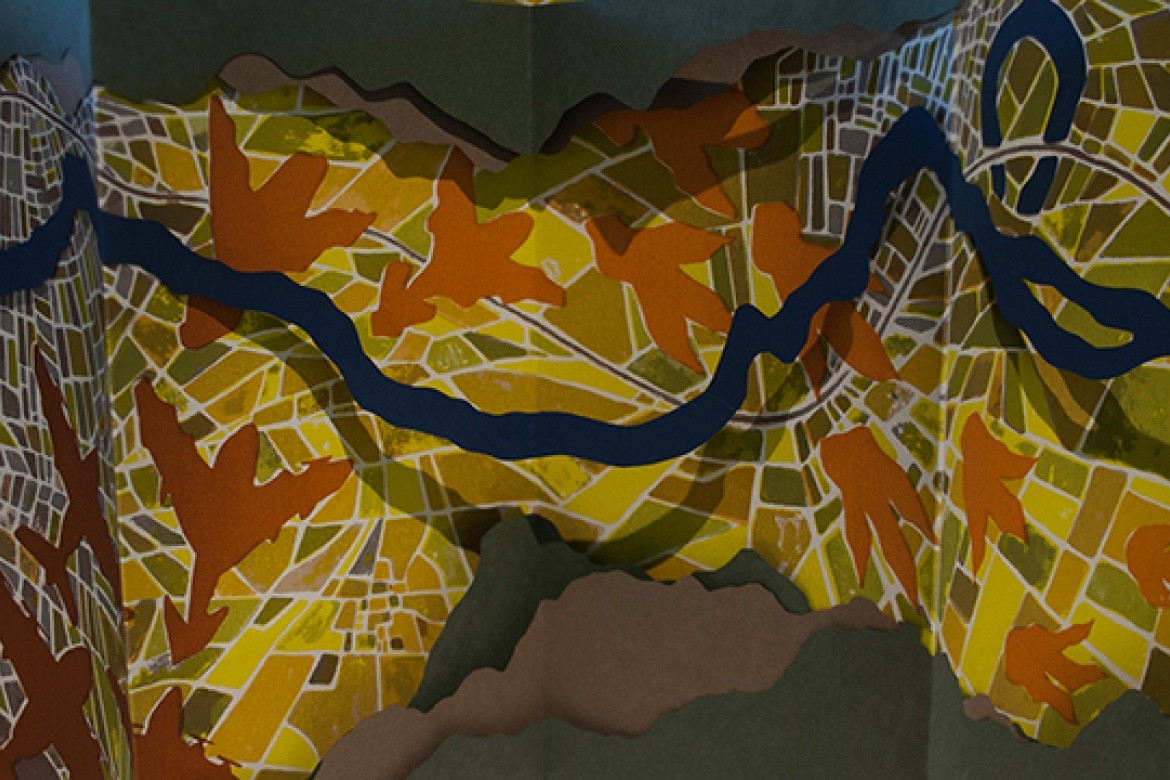Through a layered lens

Amanda Maciuba, Mount Holyoke assistant professor of art, uses the medium of printmaking to explore and express the layered complexity of the world.
By Keely Sexton
For Amanda Maciuba, who was recently promoted to assistant professor, inspiration doesn’t come from going further but going deeper.
A printmaker, Maciuba sees the layering process of her art reflected in the life around her, each iterative difference changing the world that came before — and after — bringing out new meanings, creating new questions.
A Buffalo, New York, native, she stayed close to home for college, choosing the State University of New York in her hometown. Though she had no way of predicting it at the time, her decision was fortuitous: SUNY Buffalo was home to a stellar printmaking program, and she soon realized that it was her passion.
“I just knew that this was for me,” she said. “The process of printmaking is very intentional and layered. I decided I really wanted to explore the art and discipline of printmaking.”
Maciuba’s interests lie in the way disparate processes come together to create a new whole.
“I’m interested in marks and lines and the fine details,” she said. “I am excited by the process and the layers. I like the planning, the steps and the chemistry that all work together to create a finished print.”
The gentrification she saw around her hometown of Buffalo, New York, intensified her interest in exploring community changes through her art.
“I was witnessing a lot of both positive and negative changes throughout my community, and so that influenced my research interests,” she said. “I’m interested in why communities physically look the way they do and how different aspects of a community interact with each other and how these changes are reflected in the natural and built environments that I live in,” she said.
Since her undergraduate years, Maciuba’s art has taken her across the country for residencies in locations from the Tallgrass Prairie National Preserve in Kansas to Haystack Mountain School in Deer Isle, Maine. She remembers one particular residency on Fire Island National Seashore in New York state. In the cabin next door to her were researchers from the United States Geological Survey who were there to map the seafloor.
Maciuba was soon joining them for land-based expeditions as they explained their work to her.
“Those kinds of relationships really excite me — going out into the world and learning new things from scientists and experts in their field that I can bring back to my art.”
Back at Mount Holyoke, Maciuba likes to forge connections with disparate colleagues across the campus. In 2019, her students conceived of, created and installed the sculptural piece of the annual Flower Show, a production of Mount Holyoke’s Botanic Garden. The sculpture was a collection of beeswax orbs, plexiglas and metal sheets that was suspended over an explosion of spring flowers. The effect created another fragrant and visual centerpoint for the show.
Her interest in climate change has developed in collaboration with the Campus Living Laboratory.
“In both my work and my teaching, I think about climate change, the environment and climate justice ... the interactions between our environment and people on the landscape around them is a very layered process. I like to layer these different ideas on top of each other in the work and then use the work to talk about the impacts of climate change in conversation with people viewing it.”
In the fall of 2019, Maciuba invited her students to create art about the environment. Fourteen students worked on print-based installation projects that addressed issues like climate change and human impact on the landscape in installations on the Mount Holyoke Campus, mostly focused around Project Stream.
Maciuba also works with College Archives and Special Collections, the Fimbel Maker & Innovation Lab and the Botanic Garden to connect her students to research, information and tools to deepen their artistic expressions.
With her promotion to a tenure-track position, she will have the ability to forge new and deeper connections with students and colleagues alike. She plans to refurbish the printmaking studio and update equipment so that she can resume in-person teaching with a studio fully outfitted to her students’ needs.
In addition to her classes in printmaking, Maciuba will teach drawing and book arts, which extends her connections across departments.
One of the biggest benefits Maciuba sees in teaching at a small liberal arts college such as Mount Holyoke is the access both professors and students have to each other’s disciplines and research. The collaborations that occur in both research and in the classroom are very unique and exciting. “I’m looking forward to making more long-term collaborations with colleagues in different departments as well as working with fellow faculty and students in the Art Studio Department to expand the visibility of the arts on campus,” she said.